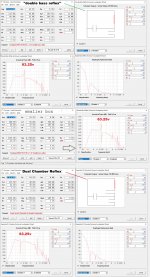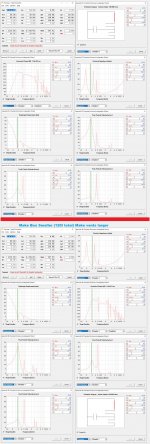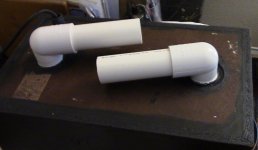Hi, I will be using a sundown nsv3 18 sub on 8kw of power.
This is going in a trunk, so space is limited.
I was planning on doing a normal reflex enclosure, but it will get tremendous cabin gain, so I would also like some added efficiency on the higher side of bass.
What is the difference between a quasi 6th order and dual reflex? Does one have better transients or efficiency?
I planned roughly that a 250l reflex tuned to 25hz with 700-800cm2 of port area, would fit in the trunk.
I might be able to get a little more air space. But would it be possible or reasonable to make a more complicated design with this space?
This is going in a trunk, so space is limited.
I was planning on doing a normal reflex enclosure, but it will get tremendous cabin gain, so I would also like some added efficiency on the higher side of bass.
What is the difference between a quasi 6th order and dual reflex? Does one have better transients or efficiency?
I planned roughly that a 250l reflex tuned to 25hz with 700-800cm2 of port area, would fit in the trunk.
I might be able to get a little more air space. But would it be possible or reasonable to make a more complicated design with this space?
Greets!
Quasi ??
6th order is either BP6 Parallel or Series AFAIK with parallel the better overall choice, especially for SQ.
Dual reflex means dual driver vented box alignment to me, so using [2] drivers?
If getting 'tremendous' cabin gain, then sealed BP4 is normally a better overall choice, especially for SQ.
Quasi ??
6th order is either BP6 Parallel or Series AFAIK with parallel the better overall choice, especially for SQ.
Dual reflex means dual driver vented box alignment to me, so using [2] drivers?
If getting 'tremendous' cabin gain, then sealed BP4 is normally a better overall choice, especially for SQ.
Hi!
dbbassflex.gif - Google Drive
This is what I meant with a dual reflex design.
Quasi is a series 6ht order bandpass. I have heard that a series tuned works better in cars especially because it has only one outer port.
How is a parallel 6th better for SQ?
This sundown driver works best in a reflex or 6th order enclosures, as it has high motor force. I do want the lows from the cabin gain, but I would also want some more highs, if possible.
If the cabin gain is too much, I can always EQ it down with my DSP, so I'd rather get as much efficiency with my enclosure, to then be able to tune it down and flat.
dbbassflex.gif - Google Drive
This is what I meant with a dual reflex design.
Quasi is a series 6ht order bandpass. I have heard that a series tuned works better in cars especially because it has only one outer port.
How is a parallel 6th better for SQ?
This sundown driver works best in a reflex or 6th order enclosures, as it has high motor force. I do want the lows from the cabin gain, but I would also want some more highs, if possible.
If the cabin gain is too much, I can always EQ it down with my DSP, so I'd rather get as much efficiency with my enclosure, to then be able to tune it down and flat.
Interestingly enough, I just finished a design for that driver (or maybe it was the 15" version) a month or so ago. Those bludy things are beasts. I basically opted for a vented box tuned to 30 Hz. I did consider other designs (like a ROAR one that looked pretty good on paper), but it took up more space than the vented box. And 6th order or dual-reflex design for that driver will take up more space than a simple bass reflex box.
You might be able to accomplish what you're trying to achieve with a 4th order BP design with the vent tuned a bit high, so you have an upward-sloping rather than flat passband response, but I suspect you're going to run into problems keeping the vent at a sufficient length to hit the target Fb and diameter to reduce chuffing. Then there's the question of getting 8kW of heat out of the box so you don't end up burning up the driver...
You might be able to accomplish what you're trying to achieve with a 4th order BP design with the vent tuned a bit high, so you have an upward-sloping rather than flat passband response, but I suspect you're going to run into problems keeping the vent at a sufficient length to hit the target Fb and diameter to reduce chuffing. Then there's the question of getting 8kW of heat out of the box so you don't end up burning up the driver...
Ah! Double Bass Reflex [AKA DCAAV]: Claudio Negro's home page, how to project and test a loudspeaker using Speaker Workshop
Nearly half the group delay, even a bit lower than a typical BR.
edit: Sundown's specs?
Nearly half the group delay, even a bit lower than a typical BR.
edit: Sundown's specs?
Last edited:
Yeah. It pretty much seems like I have to do a basic reflex design.
I don't want a 4th order, because then I lose out on the lows.
Is there any other things I could do to get more highs?
I might just have to end up leaning more on my ported 12" mids in the front doors. I have 500wrms per mid, but they should take 1000w, so I might have to get a kilowatt monoblock per mid.
I don't have the sundown specs. But I'd think it is something similar to a sundown zv5 and nsv4. The nsv3 has about 22% more bl than the zv5 and the nsv4 has 22% more bl than the nsv3. The zv5 and nsv4 specs are on sundowns website.
I don't want a 4th order, because then I lose out on the lows.
Is there any other things I could do to get more highs?
I might just have to end up leaning more on my ported 12" mids in the front doors. I have 500wrms per mid, but they should take 1000w, so I might have to get a kilowatt monoblock per mid.
I don't have the sundown specs. But I'd think it is something similar to a sundown zv5 and nsv4. The nsv3 has about 22% more bl than the zv5 and the nsv4 has 22% more bl than the nsv3. The zv5 and nsv4 specs are on sundowns website.
I planned roughly that a 250l reflex tuned to 25hz with 700-800cm2 of port area, would fit in the trunk.
Forget about that idea.
My own speakers are this volume - the size of a large fridge-freezer.
Not NO WAY will that ever fit in a vehicle, and mine weigh so much I can't move them on my own!
The rough rectangular size i can fit in the trunk is:
46cm high
100cm wide
85-95cm deep because of rear seat being angled.
By these measurements I got to fit a design with 230-250l with a 25hz tune with 800-720cm2 of port area.
I have to build it inside ode of the trunk, but it is possible.
So i yeah, I won't be able to move it, but I can get it in the trunk.
I might even be able to get more, but I won't count on that.
46cm high
100cm wide
85-95cm deep because of rear seat being angled.
By these measurements I got to fit a design with 230-250l with a 25hz tune with 800-720cm2 of port area.
I have to build it inside ode of the trunk, but it is possible.
So i yeah, I won't be able to move it, but I can get it in the trunk.
I might even be able to get more, but I won't count on that.
You might consider using plumbing pipe exterior to the cabinet to take advantage of odd trunk shape volume, while allowing a smaller cabinet.By these measurements I got to fit a design with 230-250l with a 25hz tune with 800-720cm2 of port area.
I have to build it inside ode of the trunk, but it is possible.
Using pipe couplings in the cabinet, adding 90 degree slip elbows, then pipes from the elbows allows easy changes to experiment with different Fb.
That approach would also allow angling the port, "piping" output to the cabin in the optimum place.
You could also easily disconnect the pipe if you wanted to use the port area for a trunk
Art
Attachments
could you make something relatively simple like the "Mini Devastator" for 18 inch but with more cabinet depth to accommodate a large area port ? (what's xmax for that driver?)
The Devastator Index | AVS Forum
The Devastator Index | AVS Forum
Xlim (suspension limit) appears to be the same as Xmax (40mm, that is a long stroke!) on the NSV3 15".I mean that would be an option. But as I said, I'd need 720-800cm2 of port area, so like 4x6" ports or 2x10" ports or one 12" port, just to achieve 30m/s of port air speed.
And the length was around 1,5m if i remember right. So it is still pretty hard to accommodate.
I'd think the suspension would make more noise than port chuffing as you approach either Xmax or Xlim, have you listened to the speaker free air at the excursion you are simulating?
What excursion are you simulating for 30m/s port velocity?
Are you including a high pass filter to reduce excursion below Fb to the same as the excursion maxima above Fb in the port velocity sim?
Last edited:
Is there any other things I could do to get more highs?
I don't have the sundown specs. The zv5 and nsv4 specs are on sundowns website.
OK, using the 'D1' specs, the published specs of the 18" NSv4 line up surprisingly well whereas the Zv5 winds up with a bit lower Vas, higher Qes/Qts and since there's only one dimensioned cab recommendation, the NSv4 is ~ max flat with the Zv5 is under-damped with + ~ 4 dB/38.5 Hz.
112"^2 vent recommended, but factory cab is only 93.5"^2 and both have a high vent mach @ 3 kW/19 mm Xmax, though noticed on a DIYMA? thread awhile back that claims from testing that this is acceptable in trunk apps, so FWIW/YMMV.
At 40 mm Xmax, it's of course higher, though with its significantly increased VC heating, lossy inductance, mechanical stresses it should be lower, though still in the 30s, so overall seems better to 'critically' damp the vent** or use an even bigger one [recommend 112"^2] or best choice, dual 18" PRs Vs more peak power.
Re HF response, due to its low inductance, HR predicts the NSv's HF -3 dB @ ~296 Hz referenced to its ~100 Hz mid-band efficiency and the Zv5's @ ~436 Hz referenced to its ~60 Hz.
Anyway the mean usable HF BW short of adding a FLH to the driver's face = ~[296*436]^0.5 = 360 Hz/F3.
Bottom line, without even any published NSv3 18" specs and somewhat questionable specs of these others, all this might very well be just a bunch of 'floobydust'.
** Click Test: Click Test | GM210 | Flickr
edit: Will need HPF8 below tuning
Last edited:
Yeah. I will be reconing the nsv3 18 with custom parts like a carbon dustcap and progressive spiders.
I hope to be able to loan someones woofer tester to get some parameters out of it.
The woofer has 40mm of Xmax and the original parts should have an Xmech/Xlim of 2 inches or roughly 50mm.
I have modeled with the nsv4 18D1 specs as it looks to be closest, and I will also be going with a D0.7 ohm coil just like it has.
With the progressive spider it might have even more Xmech.
But I have been modeling it on WinISD with 8kW in a 250l enclosure tuned to 25-30Hz.
And with a 20Hz hi-pass filter the excursion stays pretty nicely just at 40mm, probably even less IRL and especially in the car, acting more like a 6th order.
I have tried modeling series 6th orders and dual reflexes in both Bas Box 6 pro and hornresp, to the best of my current abilities.
With Hornresp I seemed to be able to get a lot more output with both designs than reflex, only just a hair less at the reflex's peak. This is just about what I'm going for.
I am just stuck with the overwhelming design that goes into making hornresp dimensions 3D.
I only modeled with the rough space of 250l in the enclosure. I have no idea, how much space the ports will take up, how big they should be or where they should be placed for optimal sound.
I hope to be able to loan someones woofer tester to get some parameters out of it.
The woofer has 40mm of Xmax and the original parts should have an Xmech/Xlim of 2 inches or roughly 50mm.
I have modeled with the nsv4 18D1 specs as it looks to be closest, and I will also be going with a D0.7 ohm coil just like it has.
With the progressive spider it might have even more Xmech.
But I have been modeling it on WinISD with 8kW in a 250l enclosure tuned to 25-30Hz.
And with a 20Hz hi-pass filter the excursion stays pretty nicely just at 40mm, probably even less IRL and especially in the car, acting more like a 6th order.
I have tried modeling series 6th orders and dual reflexes in both Bas Box 6 pro and hornresp, to the best of my current abilities.
With Hornresp I seemed to be able to get a lot more output with both designs than reflex, only just a hair less at the reflex's peak. This is just about what I'm going for.
I am just stuck with the overwhelming design that goes into making hornresp dimensions 3D.
I only modeled with the rough space of 250l in the enclosure. I have no idea, how much space the ports will take up, how big they should be or where they should be placed for optimal sound.
- Home
- Loudspeakers
- Subwoofers
- Dual reflex enclosure or quasi 6th order for 18" sub


